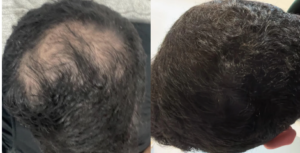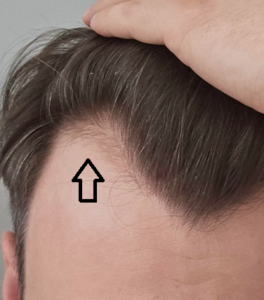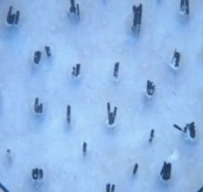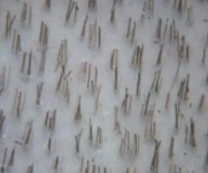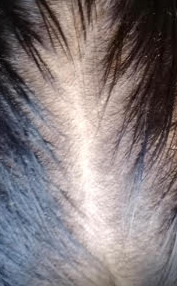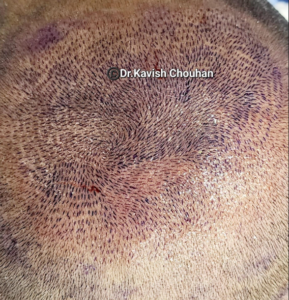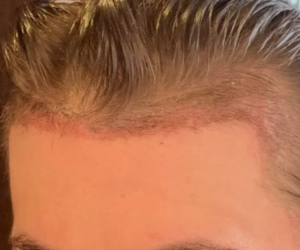Thank you for showing these photos. This is a very important set of photos. It shows that the crown is often sensitive to medication and prone to reversal for hair loss. Don’t rush to transplant your crown, give the medications a chance to work. For the crown, I have seen a reversal in 70-year-old men. Finasteride often does this alone, but it is unclear from the studies that I have read if minoxidil can reverse crown hair loss as reliably as finasteride.
I have had two hair transplants, and the result is a thin hairline that is not shaped like a juvenile hairline. I wanted it thicker and to take the shape of my juvenile hairline when I was 17 years old. Can you do this for me?
Generally, I don’t approve of creating a juvenile hairline in balding men, as you are using precious hair reserves that may be needed if you bald further back. You must recognize that a finite hair supply is available for transplantation and should be used wisely. I have created Juvenile Hairlines in special cases including 1- for exceptional actors whose jobs depended upon it and 2- for Trans patients who want to look feminine and have the hair reserves to do it. It may not be possible if you have fine hair, and even if you had coarser hair, I wouldn’t want to do it. Few doctors can create a juvenile hairline properly, so that is another reason that I don’t promote it. I don’t want this type of procedure to be the ordinary course for other young men like you.
I’ve heard mixed things on this. Some doctors have said that it can cause micro-scarring and make the scalp not viable for a transplant.If that’s the case I might want to stop. Generally I do like 1mm dermastamp once weekly.
Microneedling done at a 1.25mgg depth doesn’t go deep enough to cause significant scarring. On average, the hair follicle goes down to a depth of between 5-7 mm, so the growth of the hair follicle in the upper dermis is unobstructed by any scarring.
I have had a V-shaped hairline since birth, but at the age of 18 I noticed that the temples were constantly getting larger. Initially, I was pleased with the results of finasteride since I was 17. The hair became thicker and darker. However, I feel like I’m losing what I’ve gained. I am planning a hair transplant in the near future, and I wonder if it makes sense to start my adventure with minoxidil now? I would delay HT if the effects were promising, but I am afraid of worsening. Regarding the HR, how many grafts will I need?
An 18-year-old male should only have a hair transplant if it is for an accident where you lost part of your scalp and are doing it for reconstructive purposes. Your genetics seems to have kicked in already. Medications at your age, will likely reverse the corner recession your photo shows. If you have a hair transplant now, you will accelerate the genetics and lose all of the miniaturized hairs on your head, and the surgeon who would do it could be considered an unethical surgeon, one who just wants your money and doesn’t care about you. You would waste your donor area hair. You must wait until you are at least 25. Medications like finasteride and minoxidil might just keep your hairline where it is. The slight corner recession your photo shows is barely detectable to the average viewer. It also shows some very fine hair that can be stimulated with minoxidil and finasteride with a high degree of certainty.
https://nypost.com/2024/12/26/lifestyle/this-household-item-is-so-toxic-it-could-kill-your-pet-with-just-one-lick-i-had-no-idea/
I suspect that a lot of this is exaggerated; however, it is worth paying attention to little things like what’s on your hands when you pet licks you.
Turkey is home to many legitimate hair transplant clinics. Still, the rapid growth of this industry in this and a few other countries has led to thousands of “black market” clinics with unscrupulous practices. These clinics advertise unrealistic results and fail to disclose the risks to patients. Many have no doctors trained in hair transplantation as an art or a surgical technique. Hair is often placed in the wrong direction or in the wrong area. In too many clinics there, so much hair is removed from the donor area of the patient that they leave no reserves for future hair transplants as balding inevitably progresses, especially in young men. They prioritize volume because they don’t produce quality. Consistent aggressive marketing and time-limited offers put patients under pressure to book surgeries, leaving no time for the patients to research the clinic or consider any alternative options thoroughly.
The facts are that unlicensed technicians frequently perform these procedures, is hidden from unsuspecting buyers. Unqualified staff produced inconsistencies in the standard of care, and less than hygienic surgical practices will increase the risk of complications leading to poor results and long-term permanent damage to the patient. This damage is often irreparable. These problems are now more common than ever before, so much so that it has come to the attention of the International Society for Hair Restoration Surgeons who are speaking out against these clinics to raise patient awareness. They have created a campaign called “Fight the fight” in order to combat the black-market hair transplant industry and the growing abuse that arises out of this shadow group.
Turkey’s black-market hair transplant industry is heavily commercialized, with over 2000 clinics that don’t have trained surgeons. The Turkish Health Ministry reported 20 deaths last year, but this number may be underestimated. Follow-up appointments and post-surgical care are often left up to the patient, meaning they are virtually alone when they return home. If a patient has a complication such as skin necrosis or infection (frequent in these non-physician clinics), it is up to them to deal with it, as there is no legal recourse. One of the biggest problems that impacts patients is overharvesting of the donor area. Each patient has a limited donor graft supply. When a clinic aims to maximize its financial potential, and knowing there is little legal recourse, it will often convince patients to agree to transplant as many grafts as possible. The problem with this is that since hair loss is progressive, the progression of balding areas will likely advance as you age. Progression can even take you as far as stage 7 balding pattern on the Norwood scale, leaving you with no option of transplanting any future hair loss. This is the reason hair transplantation requires careful planning for the long term. Any surgery is just one step in possibly additional surgeries as your hair loss progresses. If you have no donor area hair left for needed future surgeries, then you may never look normal. Over-harvesting also results in damage to the donor area, leaving you looking as though you are balding in the donor area, a situation that is irreparable.
I work for Dr. Gerbrands, a board-certified hair restoration surgeon (De Haar Hair Restoration Clinic in Regina, Canada), and she has been doing hair transplants for over two decades. We are finding more and more patients driving from the US to Regina (just an hour from the US Border), many of them considered Turkey before coming to us. Some even fly to Regina. Our patients tell us that it is a better choice than going to Turkey, as the Canadian dollar now trades for 60 cents to the US dollar so not only is there value, but Canada has some of the best hair transplant doctors in the world. Canada also has some of the strictest regulations when it comes to medical practices and hair restoration clinics so you would never see a non-physician operated hair transplant clinic in Canada. Americans are learning that there safer options available for those seeking high quality, low cost, affordable transplants without the enormous risk, and that is what Canadian hair transplant surgeons offer. Americans are cashing in as they realize that they can get their hair back at an affordable price, right in their own backyard.
To read more about black market clinics and hear patient stories, please visit the ISHRS website here: https://fightthefight.ishrs.org/patient-stories.
Written by Jan Rassman
At the bottom of this posting, there are two examples of views of the donor area under a hand microscope (these can be purchased on Amazon.com). The microscopic view on the picture above averages about 2 hairs per follicular unit. This number is close to the average Caucasian’s density with a total hair count reflecting 100,000 hairs on the head. The picture below shows follicular units that contain far more than 2 hairs each (a very high donor density). Without calculating it but eyeballing it, it appears that the number of hairs exceeds 3 hairs for each follicular group or more than 150,000 hairs on the head. Let’s assume that there are 3 hairs per follicular unit for the simplicity of the calculations that follow.
The average human has 50,000 follicular units on his hair-bearing scalp, averaging 2 hairs each, which calculates to 100,000 hairs on the head. If you look at the Class 7 balding pattern patient, the remaining hair is the only hair that we can legitimately call permanent hair. This reflects 20% of the hair-baring surface on the scalp (excluding neck hair), i.e., in a typical Caucasian male, 20% of the 100,000 hairs are permanent hairs for transplantation, which is 20,000 hairs or 10,000 permanent Follicular Units (grafts). That means the area would be completely bald if 10,000 grafts were taken out of the Class 7 patterned area. Therefore, the obvious question is how many grafts of these 10,000 permanent hair Folliclar Units (grafts) we can move. The answer depends on a series of factors, but if you have medium-weight hair (50 microns thick/hair), you can safely move up to 60%, or 6,000 grafts with the FUE technique. If your hair is more coarse, the number of harvestable grafts can be higher so that the remaining follicular units (grafts) will be enough to make the donor area look normal as the hair mass is what determines if you are overharvested. Coarser hair has a higher hair mass than medium-weight hair. However, if the hair is fine, the number of safe extractions will drop below the 6,000 Follicular Units (grafts) that can be safely harvested because if you removed 6000 grafts with fine hair, the residual donor hair mass might not be enough to prevent a see-through donor area. When you or your surgeon push these numbers higher (assuming your hair is fine), you take a risk of donor area depletion, which produces a see-through donor area (i.e., balding in the donor area). This is why I am writing this post, to give you, the reader, the power to understand the logic in the decisions on estimating the maximum number of grafts you can move before risking a see-through donor area.
20% of the 100,000 hairs are permanent hairs for transplantation, which is 20,000 hairs or 10,000 permanent Follicular Units (grafts). That means the area would be completely bald if 10,000 grafts were taken out of the Class 7 patterned area. Therefore, the obvious question is how many grafts of these 10,000 permanent hair Folliclar Units (grafts) we can move. The answer depends on a series of factors, but if you have medium-weight hair (50 microns thick/hair), you can safely move up to 60%, or 6,000 grafts with the FUE technique. If your hair is more coarse, the number of harvestable grafts can be higher so that the remaining follicular units (grafts) will be enough to make the donor area look normal as the hair mass is what determines if you are overharvested. Coarser hair has a higher hair mass than medium-weight hair. However, if the hair is fine, the number of safe extractions will drop below the 6,000 Follicular Units (grafts) that can be safely harvested because if you removed 6000 grafts with fine hair, the residual donor hair mass might not be enough to prevent a see-through donor area. When you or your surgeon push these numbers higher (assuming your hair is fine), you take a risk of donor area depletion, which produces a see-through donor area (i.e., balding in the donor area). This is why I am writing this post, to give you, the reader, the power to understand the logic in the decisions on estimating the maximum number of grafts you can move before risking a see-through donor area.
One reality is that most people don’t bald to a Class 7 pattern (only 7% of the male population), but might stop at a Class 6 pattern of balding, so if you and your surgeon decide that you are willing to extend the donor area to the Class 6 pattern of balding, then the number of permanent  hairs will increase to 30,000 hairs, and the number of harvestable grafts will be much higher with harvestable grafts (assuming that your hair is medium weight) to possibly at 9,000 Follicular Units (or grafts) leaving 6,000 remaining follicular units to cover the donor area (this is the size of the Class 6 pattern of remaining hair). The decision to increase the projected size of the donor area has its risks because no one will know for sure that they will never develop a Class 7 pattern. The consequences of this decision is (1) the extra 3,000 transplanted grafts will not live and might die if you develop a Class 7 pattern of balding, and (2) the harvested area will show with FUE white scars which will be visible to others. So this decision should not be taken lightly and it must be discussed with your doctor at the time of the FUE, or you may regret the decision sometime in the future.
hairs will increase to 30,000 hairs, and the number of harvestable grafts will be much higher with harvestable grafts (assuming that your hair is medium weight) to possibly at 9,000 Follicular Units (or grafts) leaving 6,000 remaining follicular units to cover the donor area (this is the size of the Class 6 pattern of remaining hair). The decision to increase the projected size of the donor area has its risks because no one will know for sure that they will never develop a Class 7 pattern. The consequences of this decision is (1) the extra 3,000 transplanted grafts will not live and might die if you develop a Class 7 pattern of balding, and (2) the harvested area will show with FUE white scars which will be visible to others. So this decision should not be taken lightly and it must be discussed with your doctor at the time of the FUE, or you may regret the decision sometime in the future.
In the microscopic view of the patient on the right (pictures below) who shows a very high donor density, the harvestable hairs in the Class 7 area may have doubled because the look of the donor area reflects not the number of hairs that were removed, but rather the number of hairs (or follicular groups or grafts) left behind. To calculate the safe harvestable number of grafts, the key is to leave behind approximately 4000 Follicular units. With an average Follicular Unit density of 3, the donor area contains 30,000 hairs or 15,000 Follicular Units (grafts) so that to leave behind 6000 grafts, this patient can safely harvest 9000 Follicular Units (15,000 – 9,000 = 6,000).
The use of strip surgery, on the other hand, always keeps the excised donor hair at the lower side of the Class 7 permanent zone, so that if your surgeon and you decide to take more grafts, other than a risk of creating a scar, the risk of placing non-permanent hairs with the surgery is very low and the risk of seeing an area of harvested grafts with no hair will likely not occur. Of course, the risk here is potential scarring. The use of “Scalp Micropigmentation” solves the problem for either a see-through donor area or a scar. Here are examples of what can go wrong if things are not done right: https://baldingblog.com/collection-victim-photos-internet-harvested-depleted-donor-areas/
Have you ever heard about the SUT method? I just went to a clinic ( Iran is the location ), and the doctor told me that they do their transplants using this method instead of FUE. According to them, the surgery takes two days.
This is a two-day strip procedure instead of a one-day strip procedure. That allows the strip to be half the size on day one and extended on day two. Be careful that you don’t get caught up in the trap when surgeons change the name of a procedure to act like it is something they invented. I know of one good hair transplant surgeon and dermatologist in Iran, Ali Abasi, M.D.
Polycystic ovary syndrome PPCOS) is the most common endocrine disorder in women of reproductive age. ] The syndrome is named after cysts that form on the ovaries of some women with this condition, though this is not a universal symptom and not the underlying cause of the disorder. Women with PCOS may experience irregular menstrual periods, heavy periods, excess hair, acne, pelvic pain, difficulty getting pregnant, and patches of thick, darker, velvety skin. (Taken from Wikipedia). This woman also present with thinning hair, a common occurrence in such women. The single best treatment for this condition is Scalp Micropigmentation, which acts as a concealer and will make her hair look fuller.
There is a lot of rumors about finasteride side effects the most known as Post-Finasteride syndrome. But what about the opposite? Are there people who actually experienced a better mood or increased libido or both while on 5ar inhibitors? Is it uncommon? Or more common then the already rare classic sides? What causes this?
More people get an increased libido and sexual performance than people who get Post-finasteride syndrome. I say that because in my career, I have written more than 10,000 prescriptions for finasteride, and I never saw a case of Post-finasteride syndrome. Still, I have had many reports on the increased libido and sexual performance of my patient population. Dr. Bob Haber polled more than 50 high-quality hair transplant surgeons, and none of them had seen a case of Post-finasteride syndrome in their practice.
I have a question regarding your philosophy on receiving a hair transplant before the age of 25. I have read over your comments written on Reddit and Baldingblog and I want to know why you feel that way and if you make exceptions?
I make exceptions to that rule but require the following:
- Develop a Personalized Master Plan, which includes assessing the donor supply quantitatively and qualitatively.
- Making sure that I am convinced that I know the worst-case scenario for balding in that patient
- MAking sure that the patient is mature and understands the hair loss process over his lifetime
- Making sure that the patient has the finances to deal with a worst-case scenario.
If you want to go on this trip with me, then I need to see some photos to show your balding, and one of them should be a frontal view with your hair pulled back and your eyebrows lifted high so that the creases on the forehead show up. This will show me anatomical landmarks to measure where your hairline belongs and more about what a normal hairline should look like. Please tell me what you don’t like about your hairline and overall hair situation. The photos are confidential, and the initial consultation is free (unless I prescribe medications to you). Please include your phone number and the best times to reach you, as I like to establish a connection with each person I am helping, and in your case, I have to get to know you so that I am comfortable that you can meet my criteria.
First picture was in feb, 2nd picture was in June. Have been on topical min since 1 year with no results, decided to upper the dose from 1x to twice a day. Was followed by a shed but I think you can see new hair in the hairline now. Also I added fin 2 months ago, but i think that didn’t had any impact yet. I’m just extremely scared that I’m a non responder or something.
My question is. Picture a hair transplant candidate, wavy dark hair on light olive skin. Needs about 3.000 grafts and is on 1mg of finasteride/day.
Two options : A FUE operation, let’s say all 3K grafts may be extracted from the safe zone. Or, a FUT operation instead. All other factors (healing time, discomfort, price, scar) excluded. Sole criterion is the final cosmetic result. Given that FUT extracted grafts are considered , generally, healthier , bustier and less damage prone, could you give an (enen rough) estimation, on how much better would the FUT cosmetic result be? (A percent % number would be helpful, like 15% better result from FUT , or something like that)
I have seen publications where patients had FUE on one side of their head and FUT on the other, and I respect the doctors who did this because they know how to do both competently. The reports indicated that there was no difference between the two. The issue you may be missing is that the hair thickness (fine, medium, or coarse) is more important a determinant of what you would look like than FUE vs FUT. Also, the need for 3000 grafts is very dependent upon hair thickness, as men with coarse hair often require a lesser number of grafts than a man with fine hair, and even with a change in the number of grafts, the man with the coarser hair will have more fullness than the man with fine hair.
I wanted to share this fantastic photo of a patient transplanted in the crown by Dr. Kavish Chouhan from Delhi, India (tap on the image to enlarge). For a patient with enough donor hair, this photo shows the details of the graft design, following the swirl in exquisite detail. Congratulations to Dr. Chouhan.
I received 1500 grafts in the frontal hairline and 500 in the temple peak area.
Was this balding? If it was, you almost certainly lost miniaturized hairs elsewhere on your head from the surgery. If you were not on finasteride and didn’t lose any hair volume, that clearly suggests you were not balding. I question the use of 2100 grafts for such a small area. Do you know if the surgery was necessary? Will it look as natural as it did before the surgery? Using 2100 grafts reflects 25% of your total lifetime donor supply (assuming your donor density was average). I am questioning the depletion factor here if you have balding.

